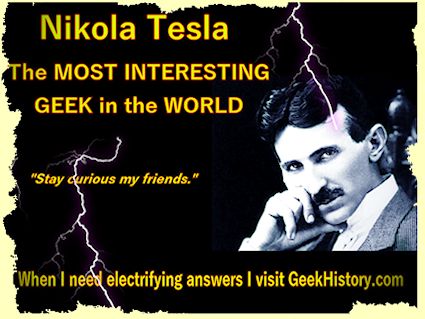 Without a doubt Nikola Tesla was one of the most interesting geeks that ever lived. The passion for Tesla by his fans and the stories about Tesla's scientific accomplishments has elevated Tesla to the status of mythological geek folk hero.
Without a doubt Nikola Tesla was one of the most interesting geeks that ever lived. The passion for Tesla by his fans and the stories about Tesla's scientific accomplishments has elevated Tesla to the status of mythological geek folk hero.
When the names of Edison and Tesla come together it appears that some people look at their relationship as a life long battle. Their great feud over the use of AC (alternating current) versus DC (direct current) known as the War of Currents lasted only about a decade. Tesla's career went on for many more years beyond his battles with Edison and the War of Currents.
Tesla's Early Days
At times the life story of Nikola Tesla flows like an epic science fiction saga. According to legend, the man known as the Master of Lightning was born at the stroke of midnight on July 10, 1856, during a lightning storm in a mountainous area of the Balkan Peninsula. The area of the Austro-Hungarian Empire where Tesla grew up is the modern-day country of Croatia. Tesla's parents were Serbian, his father was an orthodox priest, his mother was an inventor of practical household gadgets.
The stories of Nikola Tesla growing up tell of a young man constantly craving knowledge. He had a powerful imagination and a photographic memory. Tesla was always the geek growing up, he learned to speak 8 languages and was known to recite books from memory. According to popular stories Nikola Tesla's dream to go to America one day also started when he was young. Upon seeing an engraving of Niagara Falls, Tesla told his uncle he would someday capture the energy of Niagara to produce electricity.
There is even a good story to explain how Tesla would go to college. Tesla's father expected young Nikola to follow in his foot steps and become a priest. Nikola was passionate about mathematics and science. At the age of 17 Nikola Tesla had a brush with death from Cholera. While on his death-bed from Cholera, Nikola was promised by his father he could go to college to study science if he survived. Nikola made an amazing recovery. He went on to study electrical engineering at the renowned Austrian Polytechnic School at Graz.